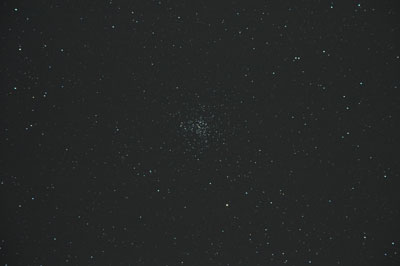The Charioteer with its 0.2m bright main star Capella is the first winter constellation that is visible in the course of the year. The star γ Aurigae is located right on the border of Taurus, where it is referred to as β Tauri. Its Arabic name “El Nath” means “Horn of the Bull”. The stars ε, η and ζ form together with Capella a small but pretty group of stars which is visible to the naked eye. The color differences between the stars η and ζ Aurigae are remarkable.
AE Aurigae is one of the “runaway stars” of the Orion association – it is moving since 2.6 million years ago at high speed away from its birthplace and forms a pair with μ Columbae, which is taking off in the opposite direction. 53 Arietis and HR 2688 form a similar pair. Why these stars “flee” from their birthplace, the Orion Nebula, that fast is still unknown. The 6.0m bright AE Aurigae is ten times brighter than our Sun, and currently illuminates the “Flaming Star Nebula” IC 405. This nebula is, however, only visible in the telescope. The star just crossed nine light-years wide and 1,500 light-years distant nebula, as you can see on an empty corridor behind the star – at least in photographs.
Only a dozen of the 60 stars of M 36 are recognizable in binoculars, the rest are blurred to a round shimmer. The 12 arc minutes wide open cluster mainly contains luminous blue stars and stands out well from other Milky Way stars. The 3,800 to 4,100 light-years distant group probably was formed around 20 to 30 millions of years ago, and has a diameter of about 14 light-years.
M 37 is the open cluster with the most stars in Auriga, but it can only be resolved in giant binoculars. Then a sparkling field of stars is visible with an orange star in the center. Smaller instruments may show only a patch of light without structure. The 24 arcmin large star cluster is about 4,600 light-years away and thus has a diameter of 25 light-years. There are no more luminous blue stars in this 200 to 300 million year old star cluster; instead it contains several old red giant stars.

M 38 is the last of the three large open star clusters in Auriga and appears in smaller binoculars only as round, 20 minutes of arc large spot of light with a few embedded stars. But a larger binocular can show you a cross shape in the star cluster. The brightest star of M 38 has nine hundred times the solar luminosity, but from 5,700 light-years away, it appears only 7.9m bright. The 70 million years old star cluster still contains some blue super giants, which will fade over the next few million years.
Harrington 4 is a 40 arc-minutes long, narrow asterism from the stars 16 (4.6m), 17 (6.1m), 18 (6.5m), 19 (5.0m) and IQ Aurigae (5.3m). The stars form two narrow, closely spaced arches that meet at 16 Aurigae and are at the limit of visibility for the naked eye.
